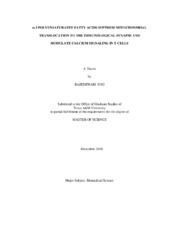| dc.contributor.advisor | Chapkin, Robert S. | |
| dc.creator | Yog, Rajeshwari | |
| dc.date.accessioned | 2011-02-22T22:24:26Z | |
| dc.date.accessioned | 2011-02-22T23:49:12Z | |
| dc.date.available | 2011-02-22T22:24:26Z | |
| dc.date.available | 2011-02-22T23:49:12Z | |
| dc.date.created | 2010-12 | |
| dc.date.issued | 2011-02-22 | |
| dc.date.submitted | December 2010 | |
| dc.identifier.uri | https://hdl.handle.net/1969.1/ETD-TAMU-2010-12-8423 | |
| dc.description.abstract | T helper (Th) cell activation is necessary for the adaptive immune response. Formation of an immunological synapse (IS) between Th cells and antigen-presenting cells is the first step in Th cell activation. In vitro studies indicate that formation of the IS induces cytoskeleton-dependent mitochondrial redistribution to the immediate vicinity of the IS. This redistribution of mitochondria to the IS in T cells is necessary to maintain Ca2 influx across the plasma membrane and Ca2 -dependent Th cell activation. Earlier studies have demonstrated that n-3 polyunsaturated fatty acids (PUFA) suppress the localization and activation of signaling proteins at the IS. Therefore, we hypothesized that n-3 PUFA suppress CD4 T cell mitochondrial translocation during the early stages of IS formation and down-modulate Ca2 dependent Th cell activation. CD4 cells derived from fat-1 mice, a transgenic model that synthesizes n-3 PUFA from n-6 PUFA, were co-cultured with anti-CD3-expressing hybridoma cells (145-2C11) for 15 min at 37 degrees C, and mitochondrial translocation to the IS was assessed by confocal microscopy. fat-1 mice exhibited a significantly (P< 0.05) reduced percentage of CD4 T cells with mitochondria which translocated to the IS; fat-1 (30 percent) versus wild type control (82 percent). With respect to an effect on the mitochondrial-to-cytosolic Ca2 ratio, wild type cells showed significant increases at the IS (71 percent) and total cell (60 percent) within 30 min of IS formation. In contrast, fat-1 CD4 T cells remained at basal levels following the IS formation. A similar blunting of the mitochondrial-to-cytosolic Ca2 ratio was observed in wild type cells co-incubated with inhibitors of the mitochondrial uniporter, RU360 or calcium release-activated Ca2 (CRAC) channels, BTP2. Together, these observations provide evidence that n-3 PUFA modulate Th cell activation by limiting mitochondrial translocation to the IS and reducing Ca2 entry. | en |
| dc.format.mimetype | application/pdf | |
| dc.language.iso | en_US | |
| dc.subject | inflammation | en |
| dc.subject | n-3 fatty acids | en |
| dc.subject | mitochondria | en |
| dc.subject | calcium | en |
| dc.subject | T cell activation | en |
| dc.subject | fat-1 | en |
| dc.subject | immunological synapse | en |
| dc.subject | nutrition | en |
| dc.title | n-3 Polyunsaturated Fatty Acids Suppress Mitochondrial Translocation to the Immunological Synapse and Modulate Calcium Signaling in T Cells | en |
| dc.type | Book | en |
| dc.type | Thesis | en |
| thesis.degree.department | Veterinary Integrative Biosciences | en |
| thesis.degree.discipline | Biomedical Science | en |
| thesis.degree.grantor | Texas A&M University | en |
| thesis.degree.name | Master of Science | en |
| thesis.degree.level | Masters | en |
| dc.contributor.committeeMember | McMurray, David | |
| dc.contributor.committeeMember | Mouneimne, Roula and Welsh, Christabel | |
| dc.type.genre | Electronic Thesis | en |
| dc.type.material | text | en |


